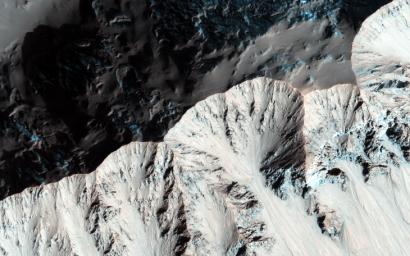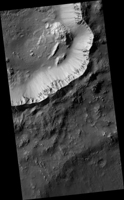
|
What Gullies Can Say
- Click the image above for a larger view
- Full-Res JPEG (2880 x 1800) (696.7 kB)
- Full-Res TIFF (2880 x 1800) (15.6 MB)
Caption:

Map Projected Browse Image
Click on the image for larger version
Right past the sharp, but warped rim of this ancient impact crater are deposits of winter frost, which show up as blue in enhanced color .
There are two possible science goals that we can study here: what does the terrain look like during the Martian summer, because HiRISE resolution can track changes over time. And second, could the gullies in this crater be a reasonable place to look for recurring slope lineae (or RSL) to occur? The slopes of certain craters have been home these phenomena in other regions as well.
Note: the images here are not map-projected, so approximate north is down.
Background Info:
HiRISE is one of six instruments on NASA's Mars Reconnaissance Orbiter. The University of Arizona, Tucson, operates HiRISE, which was built by Ball Aerospace & Technologies Corp., Boulder, Colorado. NASA's Jet Propulsion Laboratory, a division of the California Institute of Technology in Pasadena, manages the Mars Reconnaissance Orbiter Project for NASA's Science Mission Directorate, Washington.
Cataloging Keywords:
| Name | Value | Additional Values |
|---|---|---|
| Target | Mars | |
| System | ||
| Target Type | Planet | |
| Mission | Mars Reconnaissance Orbiter (MRO) | |
| Instrument Host | Mars Reconnaissance Orbiter | |
| Host Type | Orbiter | |
| Instrument | High Resolution Imaging Science Experiment (HiRISE) | |
| Detector | ||
| Extra Keywords | Color, Crater, Impact, Map | |
| Acquisition Date | ||
| Release Date | 2014-05-22 | |
| Date in Caption | ||
| Image Credit | NASA/JPL-Caltech/Univ. of Arizona | |
| Source | photojournal.jpl.nasa.gov/catalog/PIA18648 | |
| Identifier | PIA18648 | |
